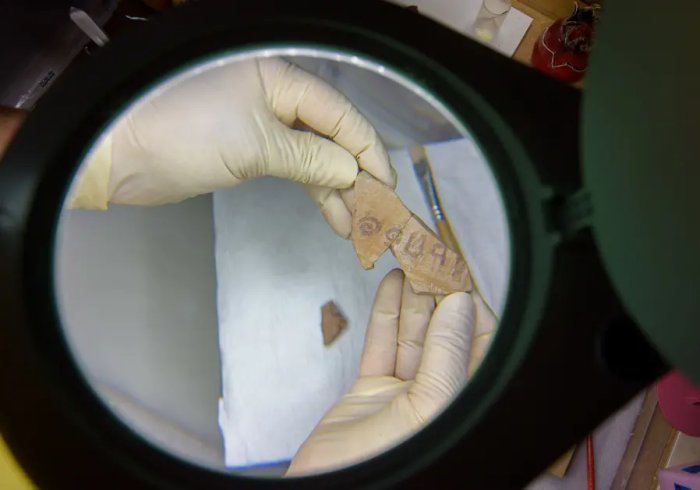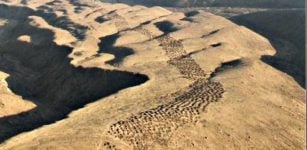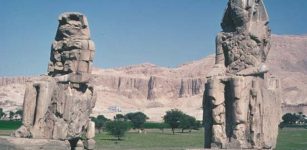Rare 3,000-Year-Old Jerubbaal Inscription Of Biblical Judge Discovered In Israel
Conny Waters – MessageToEagle.com – A rare 3,000-year-old inscription with the name of a Biblical judge has been unearthed in Israel. This important archaeological discovery sheds more light on the connection between the Biblical text and historical reality, the researchers said.
The finding will without doubt be of significance to historians, Biblical scholars, and Christians in general. Though some doubt the historical accounts described in the Bible archaeological discoveries have offered evidence several people and events were based on reality.
The Jerubbaal inscription, written in ink on a pottery vessel. Credit: Dafna Gazit/Israel Antiquities Authority
The Jerubbaal inscription, written in ink on a pottery vessel was unearthed at Khirbat er-Ra‘i, near Kiryat Gat in the Southern District of Israel.
Researchers are still cautious and say it is not entirely certain the name on the inscription refers to the individual mentioned in the Book of Judges. However, the scientists emphasize this as a unique opportunity to study the connection between the Biblical text and historical reality.
“Inscriptions from that period – the 12th-11th century BCE – are extremely rare. All the dating has been carried out through both pottery typology and radiocarbon of organic samples found in the same archaeological layer.
The writing, inked on a jug, marks the first time that the name Jerubbaal has been found outside the biblical text. It is believed that the owner penned his name on the jug, “the Jerusalem Post reports.
“The name Jerubbaal is familiar from Biblical tradition in the Book of Judges as an alternative name for the judge Gideon ben Yoash,” according to Professor Yosef Garfinkel and archeologist Sa‘ar Ganor from the Hebrew University of Jerusalem.
The Jerubbaal inscription, written in ink on a pottery vessel. Credit: Dafna Gazit/Israel Antiquities Authority
“Gideon is first mentioned as combating idolatry by breaking the altar to Baal and cutting down the Asherah pole,” they explained. “In biblical tradition, he is then remembered as triumphing over the Midianites, who used to cross over the Jordan to plunder agricultural crops. According to the Bible, Gideon organized a small army of 300 soldiers and attacked the Midianites by night near Ma‘ayan Harod.”
“Early next day, Jerubbaal – that is, Gideon – and all the troops with him encamped above En-harod, while the camp of Midian was in the plain to the north of him, at Gibeath-moreh,” reads a verse in the 7th chapter in the Book of Judges.
Excavations at the Khirbat er-Ra‘I site have been ongoing since 2015. Over the years archaeologists have unearthed many valuable artifacts in this region, including an ancient fortified city from the time of King David dating to the 10th century B.C.
“We thought we might find another fortress, but instead we only found six rooms dating back to that period, so it looks like at that point it might have been just a small village,” the archaeologist said.
“However, it turned out that that site appeared to have reached its height one or two centuries prior, that is, at the time of the Judges.
Khirbat er-Ra‘i is located close to an important archaeological site, where a center, Lachish, often featured in the Bible, once stood. In the middle of the 2nd millennium, BCE Lachish was a prominent Canaanite city. According to the Book of Joshua, shortly afterwards it was destroyed by the Israelites as they conquered the Land of Israel at the end of their wanderings in the desert following their Exodus from Egypt.
The Philistine city of Gath was also close by, “the Jerusalem Post reports.
Garfinkel suggests the archaeological discoveries offer evidence Khirbat er-Ra‘i was mainly a Canaanite site, but with a strong Philistine influence.
“I believe that the site was mostly inhabited by Canaanite refugees, who came to live under Philistine hegemony” he said.
Epigraphic expert Christopher Rolston of George Washington University who deciphered the Jerubbaal inscription observed bears five letters: yod (broken at the top), resh, bet, ayin, lamed.
Aerial view of the excavation area where the inscription was found. Credit: Dafna Gazit/Israel Antiquities Authority
“While the names of the letters might sound familiar to Hebrew speakers, the alphabet was not the Hebrew alphabet, but rather an alphabet from which the Hebrew one would evolve from centuries later,” the Jerusalem Post stated.
“The alphabetic script was invented by the Canaanites and the Egyptian influence right about 1800 BCE,” Garfinkel noted. “They continued to use this script, which evolved from Egyptian Hieroglyphs in the Late Bronze Age [1500-1200 BCE] and Iron Age I [1200-1000 BCE]. The Hebrew and Phoenician scripts were developed only in the middle of the tenth century BCE.”
The fact that the cultural affiliation of the site was not Israelite does not exclude that the inscription was referring to the Jerubbaal mentioned in the Bible. The researchers stressed that there cannot be any certainty in one direction or in another. But even if the name actually referred to another Jerubbaal, the artifact still sheds important light on the connection between the biblical text and the period it describes.
“In view of the geographical distance between the Shephelah and the Jezreel Valley, this inscription may refer to another Jerubbaal and not the Gideon of biblical tradition, although the possibility cannot be ruled out that the jug belonged to the judge Gideon,” Garfinkel and Ganor said. “In any event, the name Jerubbaal was evidently in common usage at the time of the biblical judges.”
Book of Judges Chapter 15-7. Credit: Sweet Media – CC BY-SA 3.0
“As we know, there is considerable debate as to whether biblical tradition reflects reality and whether it is faithful to historical memories from the days of the Judges and the days of David,” they added.
Jerubbaal only appears in the Bible in the period of the judges, Garfinkel and Ganor remarked and yet “now it has also been discovered in an archaeological context, in a stratum dating from this period.”
See Also: More Archaeology News
“In a similar manner, the name Ishbaal, which is only mentioned in the Bible during the monarchy of King David, has been found in strata dated to that period at the site of Khirbat Qeiyafa,” they further said referring to a previous discovery they authored.
“The fact that identical names are mentioned in the Bible and also found in inscriptions recovered from archaeological excavations shows that memories were preserved and passed down through the generations,” Garfinkel and Ganor concluded.
Written by Conny Waters – MessageToEagle.com – AncientPages.com Staff Writer














